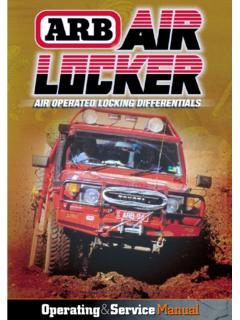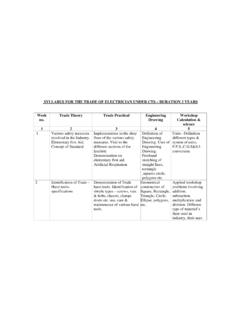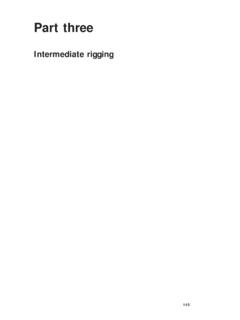Transcription of ANCHOR HANDLING MANUAL - …
1 1 ANCHOR HANDLING MANUAL M/V XXXXXXXXX Original Date: Revision: Revision Date: Prepared by: Approved by: ANCHOR HANDLING MANUAL M/V XXXXXXXXXXX OFFICIAL NUMBER: XXXXXX IMO NUMBER: XXXXXX PORT OF REGISTRY: XXXXXX Copy Number 1 of 2 2 ANCHOR HANDLING MANUAL M/V XXXXXXXXX Original Date: Revision: Revision Date: Prepared by: Approved by: FOREWORD As a result of the tragic disaster with Bourbon Dolphin in April 2007, the Norwegian Maritime Directorate (NMD) issued various actions for immediate implementation on all Norwegian flagged AHTS vessels and all other vessels working within Norwegian waters. This MANUAL shall be read and understood by all crew directly or indirectly involved in any rig move and towing operations. Particular attention should be paid to vessel stability and emergency procedures, especially the Controlled Release System.
2 Once a thorough review of the contents within has been completed the below table shall be signed: Rank Name Signature Rank Name Signature 3 ANCHOR HANDLING MANUAL M/V XXXXXXXXX Original Date: Revision: Revision Date: Prepared by: Approved by: DOCUMENT DESCRIPTION DISTRIBUTION Copy Number Receiver 1 M/V XXXXXXXXXXXXX 2 Company Name DOCUMENT INFORMATION Document Title ANCHOR HANDLING MANUAL Document Identification Replaces Document File REVISION STATUS Rev No. Description Prepared Controlled Approved Date 4 ANCHOR HANDLING MANUAL M/V XXXXXXXXX Original Date: Revision: Revision Date: Prepared by: Approved by: TABLE OF CONTENTS Section 0 Section 1 Introduction ANCHOR HANDLING Operations 1.
3 Stability 2. Communications 3. Set Up 4. Bollard Pull 5. Quick Release and Emergency Stop Winch Karm Fork 6. Anchors 7. The Rig Move Recovery Deployment Deep Draught Pennant Wires and Buoys 8. Variations The Mid-line Buoy The Rope insert The Wire Insert Grappling J-Hooking 9. Deep Water Operations (Tandem/Joint Towing Operations) 10. Towing 11. Jack-up Rigs 12. Pipe Lay Barges 13. Record Keeping 5 ANCHOR HANDLING MANUAL M/V XXXXXXXXX Original Date: Revision: Revision Date: Prepared by: Approved by: 14. Training 15. Personal Protective Equipment Section 2 ANCHOR HANDLING and Towing Procedure Section 3 Bollard Pull Calculations Section 4 Stability Calculations Section 5 Risk Assessments Section 6 Winch Details and Emergency Release Test Procedure Section 7 Karm Fork Details and Emergency Release Test Procedure Section 8 Winch Emergency Release Maintenance Section 9 Karm Fork Emergency Release Maintenance 6 ANCHOR HANDLING MANUAL M/V XXXXXXXXX Original Date: Revision: Revision Date: Prepared by: Approved by: Section 1 ANCHOR HANDLING Operations Introduction This MANUAL is intended to provide guidance for safe ANCHOR HANDLING operations on board this vessel.
4 It should be read in conjunction with Company procedures, international guidelines and specific procedures provided by charterers. ANCHOR HANDLING involves a number of special marine operations. The high tensions experienced in chains and wires may cause high heeling moments and may cause high transverse and/or astern movements of the ANCHOR HANDLING vessel. The vessel s motion through the water may also be affected by high hauling speed on the ANCHOR HANDLING winch or as result of any loss of bollard pull. The vessel may be pulled astern at speed by the tension in a heavy ANCHOR arrangement. Any simultaneous loss of thrust, for any reason, on the vessel may lead to a rotation which would lead to considerable extra transverse forces. Environmental conditions will also influence the operations. For these reasons the vessel s stability needs to be closely monitored.
5 Operations on deck involve other hazards of which all personnel should be aware. Familiarity with the contents of this MANUAL is essential to all personnel involved in the ANCHOR HANDLING operations. Teamwork is essential. It is not possible to describe every situation as all jobs are different but general guidelines for stability, winch HANDLING and ANCHOR HANDLING operations are given below. The Master or any person, having any concerns about the Operation, will STOP THE JOB . 7 ANCHOR HANDLING MANUAL M/V XXXXXXXXX Original Date: Revision: Revision Date: Prepared by: Approved by: 1. Stability Stability of vessel should be checked prior to starting. In addition to sailing condition, stability calculations should consider worst case scenarios which may occur towards the end of a prolonged job. Printouts of these conditions are to be displayed throughout the operation and reviewed as soon as there is any event which may change the vessel s condition.
6 Any criteria in the approved Stability Booklet must be adhered to. Prior to sailing a document must be displayed on the bridge, where it is visible to be navigator on duty, to show the acceptable vertical and horizontal transverse force/tensions to which the vessel can be exposed. This should show a sketch of the GZ curve and a table of the tension/forces which give the maximum acceptable heeling moment. Calculations must show the maximum acceptable tension in wire/chain, including transverse force, that can be accepted in order for the vessel s maximum heeling to be limited by one of the following angles:- a) Heeling angle equivalent to a GZ value equal to 50% of GZ max. b) The angle of flooding of the work deck the angle which results in water on working deck when the deck is flat. c) 15 degrees. The calculation should then be made to show the maximum force from the wire/chain, acting down at the stern roller and transversely to the outer pins, which would be acceptable without taking the vessel beyond the angles stated above.
7 The heeling moment based on transverse bollard pull must also be shown and allowed for. NMD ANCHOR HANDLING guidelines suggest that the vertical component is to be taken as the distance (vertically) from the deck at the tow pins to the centre of the stern thruster or propeller shaft, whichever is the lower. The notice to be posted should also show the maximum force in the wire/chain as well as the point where the lateral force is assumed to be applied (towing pin/stern roller). 8 ANCHOR HANDLING MANUAL M/V XXXXXXXXX Original Date: Revision: Revision Date: Prepared by: Approved by: The maximum vertical pull on the wire/chain must not be such as to exceed those limits given above or to exceed the SWL of the roller. It may be necessary to obtain some of the information needed for the above calculations from the charterer or their representative. If a deep water move is planned, weight on stern roller can be hundreds of tonnes, which will be applied at a distance off centre line according to the set-up of the towing pins.
8 This will add to listing moments and stern trim; this type of vessel usually suffers reduction of stability and the deck edge is immersed earlier as the stern trim increases. A flooded deck at this point, from a breaking wave can also cause a temporary reduction in stability. Fuel consumption from double bottoms must also be considered along with use of fresh water and ballasting condition. Before any ballasting operation is carried out the operator should be aware of the immense effect on stability of having any tank slack, particularly transverse roll reduction tanks. Consideration should be given to the maximum listing/heeling angle which would be acceptable during the operation and forethought given to what action to take should such an angle be approached. To preserve stability, by reducing the risk of flooding, all watertight doors which open onto the maindeck and give access to underdeck spaces should be kept shut, except for access, throughout the operation.
9 All such doors should be marked to the effect that they should not be left open during ANCHOR - HANDLING or towing operations. A summary sheet containing a GZ curve and Loading Condition Summary for the current voyage, as per example in Section 4, should be inserted in a pocket inside the front page of the MANUAL . 2. Communications Externally Communications between all parties are vitally important. The more people who know what is going on the safer the job will be. Briefings should be shared by as many as possible. Contingency plans should be discussed before the operation. Internally Communication between bridge, where the master and winch driver will be, and the ANCHOR HANDLING deck must be decided prior to the operation. 9 ANCHOR HANDLING MANUAL M/V XXXXXXXXX Original Date: Revision: Revision Date: Prepared by: Approved by: Dependent on vessel s equipment and the operation concerned, the best means of communication may be personal UHF radios or by loudspeaker.
10 Whichever means of communication is decided upon; it should be thoroughly tested prior to starting the operation. Pre-sailing: A procedure book is produced with all relevant information and should be supplied to the vessel on confirmation of contract. A tow master and marine rep are appointed by the oil company involved, and a pre rig move meeting and safety briefing should be held on board prior to mobilisation. If this is not possible, rig move procedures are to be transmitted to the vessel and agreed by Tow Master and Vessel Crew. Relevant risk assessments should be reviewed and discussed, a new risk assessment should be written for any unusual operation being planned. Pre-operation: Particularly where two vessels are working together, a communication plan for the operation must be established which in particular ensures an effective and coordinated action in the event of any unintended incident.









